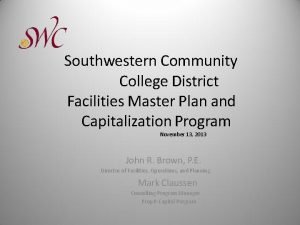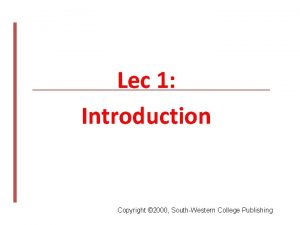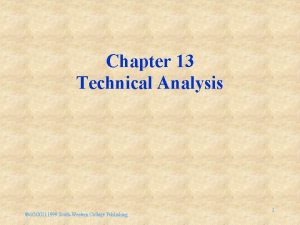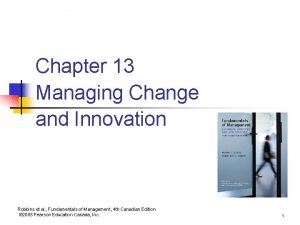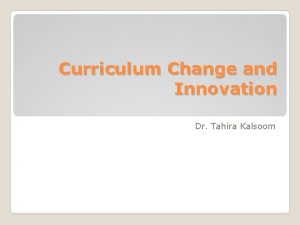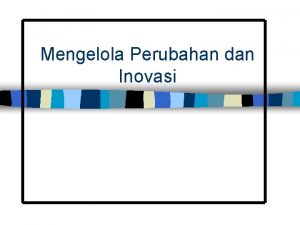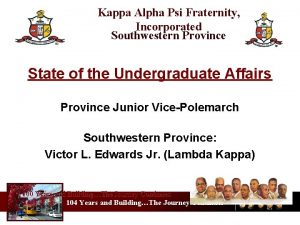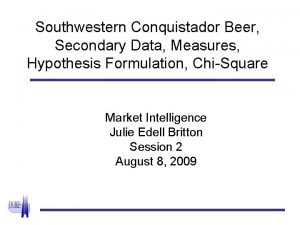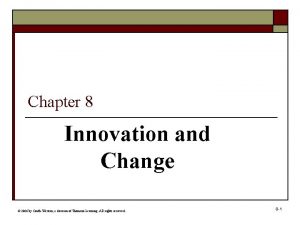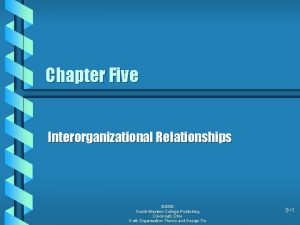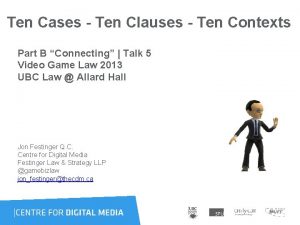Chapter Ten Innovation and Change 2000 SouthWestern College















- Slides: 15

Chapter Ten Innovation and Change © 2000 South-Western College Publishing Cincinnati, Ohio Daft, Organizational Theory and Design, 7/e 1 10 -1

Forces Driving the Need for Major Organizational Change Global Changes, Competition and Markets • Technological Change • International Economic Integration • Maturation of Markets in Developed Countries • Fall of Communist and Socialist Regimes More Threats More domestic competition Increased Speed International competition More Opportunities Bigger markets Fewer barriers More international markets More Large-Scale Change in Organizations Structure change Strategic change Culture change Knowledge management, enterprise Resource planning Quality programs Source: Based on John P. Kotter, The New Rules: How to Succeed in Today’s Post-Corporate World (New York: The Free Press, 1995). Mergers, joint ventures, consortia Horizontal organizing, teams, networks New technologies, products New business processes E-commerce Learning organizations © 2000 South-Western College Publishing Cincinnati, Ohio Daft, Organizational Theory and Design, 7/e 2

Incremental vs. Radical Change Incremental Change Radical Change Continuous progression Paradigm-breaking burst Affect organizational part Transform entire organization Through normal structure and management processes Create new structure and management Technology improvements Breakthrough technology Product improvement New products, new markets Sources: Based on Alan D. Meyer, James B. Goes, and Geoffrey R. Brooks, “Organizations in Disequilibrium: Environmental Jolts and Industry Revolutions, ” in George Huber and William H. Glick, eds. , Organizational Change and Redesign (New York: Oxford University Press, 1992), 66 -111; and Harry S. Dent, Jr. , “Growth through New Product Development, ” Small Business Reports (November 1990): 30 -40. © 2000 South-Western College Publishing Cincinnati, Ohio Daft, Organizational Theory and Design, 7/e 3

Four Types of Change • Technology – Changes in production process • Products and Services – Changes in outputs • Strategy and Structure – Administrative changes • Culture – Changes in values, attitudes, behaviors © 2000 South-Western College Publishing Cincinnati, Ohio Daft, Organizational Theory and Design, 7/e 4

Sequence of Elements for Successful Change Environment Suppliers Professional associations Consultants Research literature Internal Creativity and Inventions Organization 1. Ideas 3. Adoption Customers Competition Legislation Regulation Labor force 4. Implementation 2. Needs 5. Resources Perceived Problems or Opportunities © 2000 South-Western College Publishing Cincinnati, Ohio Daft, Organizational Theory and Design, 7/e 5

Division of Labor Between Departments to Achieve Changes in Technology General Manager Creative Department (Organic Structure) Using Department (Mechanistic Structure) © 2000 South-Western College Publishing Cincinnati, Ohio Daft, Organizational Theory and Design, 7/e 6

Probability of New Product Success PROBABILITY • Technical completion – (technical objectives achieved) • Commercialization – (full-scale marketing) • Market Success – (earns economic returns) Source: Based on Edwin Mansfield, J. Rapaport, J. Schnee, S. Wagner, and M. Hamburger, Research and Innovation in Modern Corporations (New York: Norton, 1971), 57. © 2000 South-Western College Publishing Cincinnati, Ohio Daft, Organizational Theory and Design, 7/e . 57. 31. 12 7

Horizontal Linkage Model for New Product Innovations Organization Environment General Manager Technical Developments Linkage R&D Department Li nk Linkage Marketing Department Linkage Customer Needs e ag g ka n Li e Production Department © 2000 South-Western College Publishing Cincinnati, Ohio Daft, Organizational Theory and Design, 7/e 8

Dual-Core Approach to Organization Change Type of Innovation Desired Administrative Structure Administrative Core Technology Technical Core Direction of Change: Top-Down Bottom-Up Examples of Change: Strategy Downsizing Structure Production Techniques Workflow Mechanistic Organic Best Organizational Design for Change: © 2000 South-Western College Publishing Cincinnati, Ohio Daft, Organizational Theory and Design, 7/e 9

Culture Change • Reengineering and Horizontal Organization • Total Quality Management • The Learning Organization © 2000 South-Western College Publishing Cincinnati, Ohio Daft, Organizational Theory and Design, 7/e 10

OD Culture Change Interventions • Large group intervention • Team building • Interdepartmental activities © 2000 South-Western College Publishing Cincinnati, Ohio Daft, Organizational Theory and Design, 7/e 11

Stages of Commitment to Change • Preparation – – Initial contact Awareness • Acceptance – Understanding – Decision to implement • Commitment – Installation – Institutionalization © 2000 South-Western College Publishing Cincinnati, Ohio Daft, Organizational Theory and Design, 7/e 12

Barriers to Change • Excessive focus on costs • Failure to perceive benefits • Lack of coordination and cooperation • Uncertainty avoidance • Fear of loss © 2000 South-Western College Publishing Cincinnati, Ohio Daft, Organizational Theory and Design, 7/e 13

Techniques for Change Implementation • • Identify a true need for change. Find an idea that fits the need. Obtain top management support. Design the change for easy implementation (in stages/steps). • Develop plans to overcome resistance. • Create change teams. • Foster idea champions. © 2000 South-Western College Publishing Cincinnati, Ohio Daft, Organizational Theory and Design, 7/e 14

Workbook Activity Innovation Measures Measure A Your Organization B Other Organization C Your Ideal 1. Creativity encouraged 2. Diverse problem-solving 3. Time for creative ideas 4. Rewards for innovation 5. Flexible, open to change 6. Follow orders from top 7. Think and act like others 8. Concern for status quo 9. Don’t rock the boat 10. New ideas not funded © 2000 South-Western College Publishing Cincinnati, Ohio Daft, Organizational Theory and Design, 7/e 15
 Southwestern community college
Southwestern community college South-western college publishing
South-western college publishing Southwestern college publishing
Southwestern college publishing Southwestern college cincinnati ohio
Southwestern college cincinnati ohio South western college publishing
South western college publishing Managing change and innovation
Managing change and innovation The calm waters metaphor
The calm waters metaphor Mysite socccd
Mysite socccd Incremental innovation vs disruptive innovation
Incremental innovation vs disruptive innovation Numbers ten twenty thirty
Numbers ten twenty thirty Ten ten siempre fuerzas y esperanza
Ten ten siempre fuerzas y esperanza Ten ten program
Ten ten program Linkage model in curriculum
Linkage model in curriculum Mengelola perubahan dan inovasi
Mengelola perubahan dan inovasi Keonte turner
Keonte turner Southwestern conquistador beer case solution
Southwestern conquistador beer case solution
